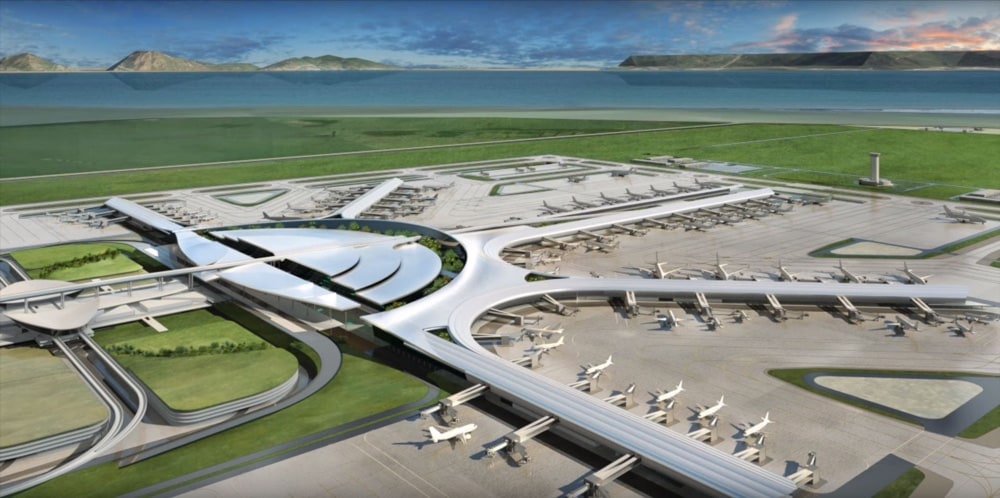The Bulacan International Airport (also known as the New Manila International Airport) is a proposed Bulacan airport that aims to alleviate the air congestion at the Ninoy Aquino International Airport (NAIA). This airport in Bulacan came about through an unsolicited proposal by the San Miguel Corporation to be built in the coastal areas of Bulakan, Bulacan. This is one of the towns in Bulacan, about 35 km north of Metro Manila.
Bulacan Airport Master Plan

February 26, 2020 – The Department of Transportation (DOTr) gave the go-signal to San Miguel Corp. (SMC) for the airport groundbreaking. SMC can proceed any time with the actual construction of the new international airport in Bulacan, despite the clarifications being sought by the Department of Finance (DOF) on certain provisions in the concession agreement.
This Bulacan airport will be a Public-Private Partnership (PPP) that involves the construction and operation & maintenance of a new modern airport in Bulacan, with a design capacity that can be expanded up to 200 million passengers per year, consisting of 4 runways and all aviation-related facilities. It is a Build-Operate-Transfer (BOT) structure with a cooperation period of 50 years.
The notice of award was issued on August 14, 2019.
Read: DOTr gives go-signal to SMC for airport groundbreaking

Where is the New Bulacan Airport?
The $15-billion (PhP736B) Bulacan International Airport project will be built on a 2,400-hectare property in Bulakan, Bulacan. It will have four runways, eight taxiways, and three terminals. It plans to handle 100 million passengers per year once fully completed in six years.

As seen on the map, the property has a coastal location. Thus, the proposed canal system of the Bulacan International Airport will have a ring road along its banks. This will serve as the flood mitigation to channel run-off water to the Manila Bay.

The actual construction is expected to start within the year 2020 according to the news. However, with the course of the COVID-19 pandemic in the country, the official start of the construction date is currently on hold.
Bulacan Airport Connected to NLEX and Metro Manila

The plans include the construction of an 8.4-kilometer tollway that will connect it to the North Luzon Expressway (NLEX) in Marilao, Bulacan.
There is a plan to connect the Bulacan Airport with the Metro Rail Transit (MRT) line 7. The plan emulates other first-world countries where the airport is connected to the train or subway system that links to the metropolis. Airport passengers can come to the airport without the need of bringing a car. Likewise, when the passenger arrives from abroad or local travel, he/she doesn’t need to hire a cab to go home.
A planned elevated Airport Express will traverse the cities of Quezon, Caloocan, Malabon, and Navotas from New Manila International Airport (NMIA) in Bulakan, Bulacan to EDSA, Quezon City (spanning 200 kilometers).
While the stations are still in the planning stage, the MRT Loop is envisioned to include a non-stop high-speed train that would allow fast transfer of passengers between EDSA and the Bulacan Airport. Ramon Ang, CEO of SMC, promises travelers can get to the airport from Metro Manila in as little as 20 minutes.
Comparison of Bulacan Airport and Clark Airport
- Distance from Manila
- Bulacan Airport: 35km
- Clark Airport: 98km
- Connection to Manila / Highway system
- Bulacan Airport: planned connection to NLEX; planned elevated train system to connect to EDSA
- Clark Airport: connected to Subic-Clark-Tarlac Expressway (SCTEx) which can connect it to Northern Luzon provinces; with interchange to NLEX that can connect it southbound to Pampanga, Bulacan, and towards EDSA to Metro Manila
- Volume
- Bulacan Airport: A planned capacity for 100M passengers per year
- Clark Airport: almost 25,000 aircrafts catering to 2.66M passengers (actual 2018 data)
- Size:
- Bulacan Airport: 2,400 hectares
- Clark Airport: 2,367 hectares